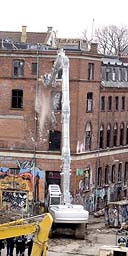The "Ungdomshuset" or Youth House which once hosted Vladimir Lenin, has been the focus of street riots in recent days following the eviction of squatters from the building which has been sold to a rightwing Christian sect.
Yesterday demonstrators laid flowers at the end of Jagtvej Street in the workers' district of Noerrebro as dust from the demolition filled the air.
"This is a funeral," said Siggi Oddsson, 22, who laid a cloth banner reading "Loved and Missed". "This is an absolute milestone of underground culture in Copenhagen and it's being destroyed," he said. "Forget the idea of 'wonderful, wonderful Copenhagen'."
Behind him, a silver crane - the name of the company it belonged to concealed under a layer of paint - hovered above the graffiti-covered structure of house number 69. Workers wore face masks under their helmets so as not to be identified as they worked under police guard, and even the trucks taking away the rubble were escorted through the city by armed police.
Many surrounding shops were either boarded up or had had their windows smashed following three nights of clashes between police and protesters. Graffiti read "69 Blir" - or "number 69 stay" and "Revenge!".
The four-storey red brick building has been a popular meeting point for leftwing anarchists, punk rockers, and musicians since the local government allowed young people to use it in 1982. It quickly became a focal point for anti-capitalist activism.
But its importance as a place where political history was made goes back further. Built as a community theatre for the labour movement in 1897, it was here that both Denmark's women's liberation and trade union movements were founded. Lenin paid a visit in 1910 during the Socialist International Congress and it has played host to modern musicians such as Bjork and Nick Cave.
But it has been a point of contention between inhabitants and the local government since 1995 when a fire which damaged the building prompted the city to decide to sell it. A squat was formed whose occupants hung a banner from the windows which read: "For sale, including 500 violent-loving psychos."
In 2000 when it was sold to a religious group, the tension grew. Court orders for the squatters to leave were ignored, with occupants saying the authorities had no right to sell the building. Then on Thursday 35 squatters were removed by riot police who swooped onto the building's roof in helicopters in a surprise operation.
The evictions triggered three nights of riots, with a handful of anarchists setting fire to cars, rubbish bins and shops, leading to justice minister Lene Espersen's call to remain calm.
Sympathy protests have been held around Europe, including Germany, and Finland, while activists from the US have flown to the Danish capital to offer support. Danish police have increased border controls as a result. Extra police vehicles have been lent by Sweden and Holland and the prisons director reported that the prisons were "bulging" following more than 650 arrests.
British accident and emergency nurse Naja Brooks, 34, from London, said she was "in mourning" for a building where she said she had grown up. "I started coming to the house when I was 14 or 15," she said. "There was music, art, photo studios - it was a place where you could really express yourself and you were aware of its fantastic history as well."
Thea, 25, a tailor, said the house's destruction was a consequence of Denmark's drift to the political right and the erosion of the welfare system. The protests were as much a demonstration against the government of prime minister Anders Fogh Rasmussen as an attempt to save the centre, she said.
"We used to be tolerant as a nation, but we have become very intolerant towards anyone who doesn't want to toe the line," she said.
Ruth Evensen, leader of the Faderhuset Christian sect which has bought the site, insisted yesterday the house had to be torn down as it was "a total wreck" and a potential fire hazard. "It would cost us a fortune to have it fixed," she said, refusing to divulge how the congregation would use the site.
Three bad days
· Three nights of clashes with youths ended with more than 650 arrests
· At least 25 were injured as protesters hurled cobblestones at riot police
· Those arrested in the riots included more than 140 foreign activists
· 189 people were remanded in custody, while 26 were released
· Danish police said yesterday they had borrowed 16 lightly-armoured vans from Dutch authorities and 20 police vehicles from Sweden
· The riots were the worst since May 1993 when police fired into a crowd protesting at the result of a EU referendum. Ten people were wounded
Source: AP



